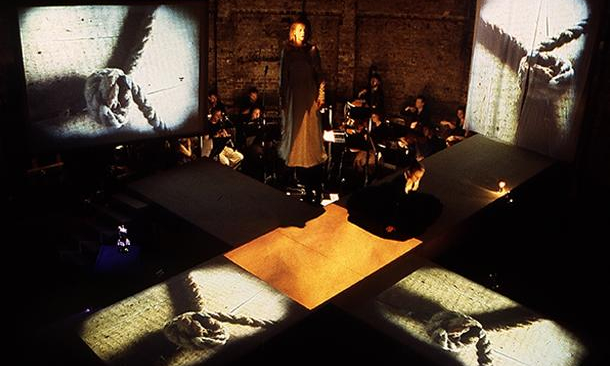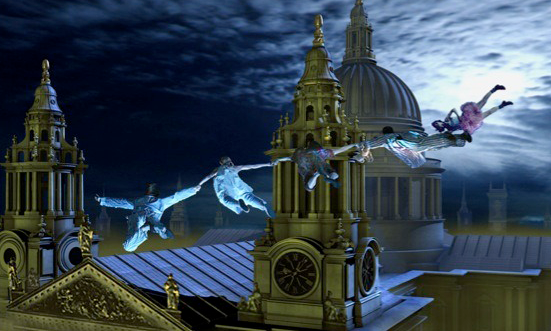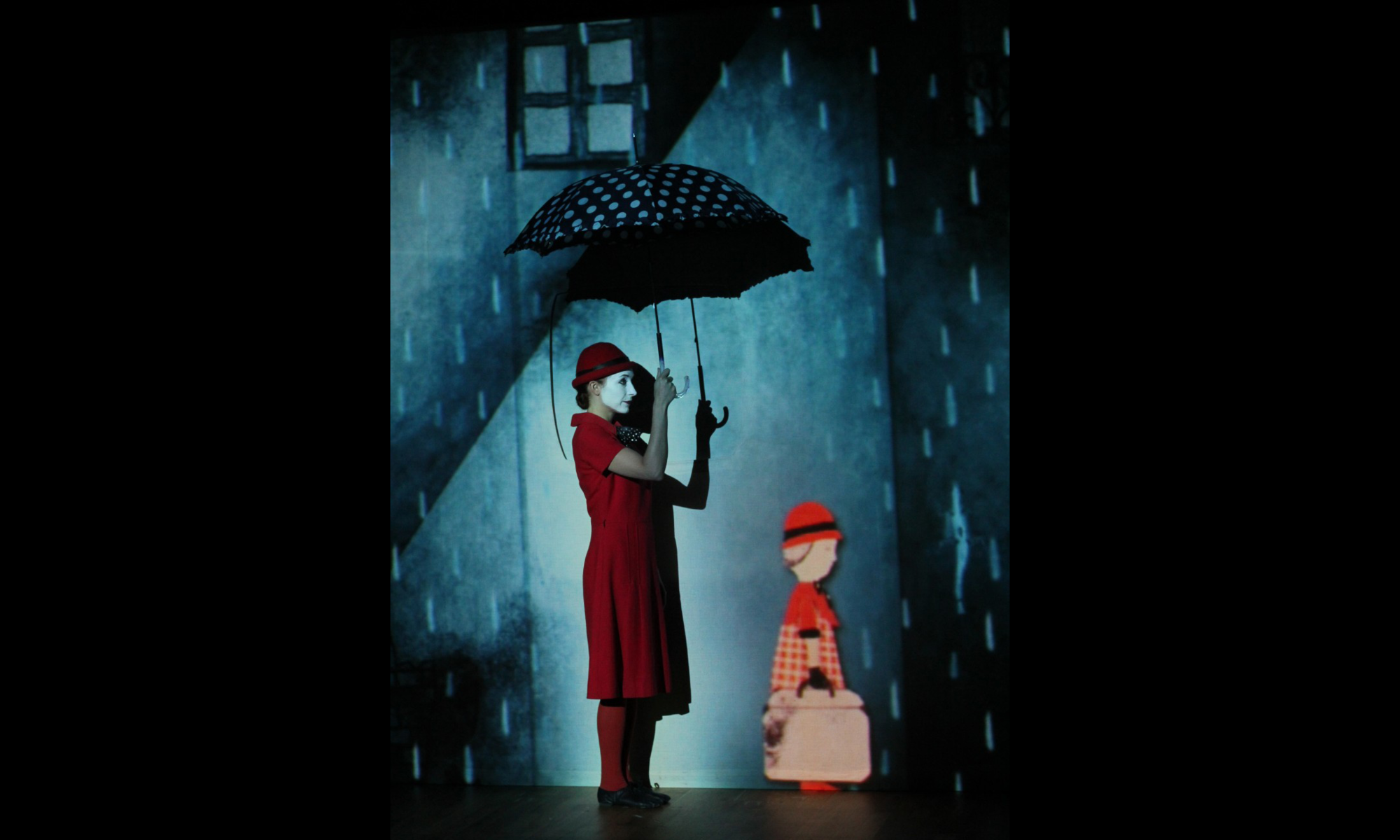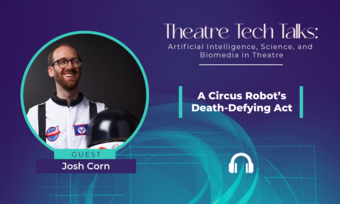Media as mirror
David Rokeby, creator of the pioneering interactive installation Very Nervous System (1986–1990), proclaims that “an interactive technology is a medium through which we communicate with ourselves… a mirror. The medium not only reflects back, but also refracts what it is given; what is returned is ourselves, transformed and processed.”
Media functions as a mirror when it reflects the performer’s actions. The most banal example is the kind of live-feed video used to help spectators see close-ups of musical performances and athletic events in huge stadium venues—though, as the Wooster Group has demonstrated in a series of productions over the past fifty years, such technically straightforward live-feed video can be used to highly sophisticated aesthetic effect.
To function as a media mirror, however, the media need not visually resemble the performer at all. What matters is that the spectators perceive a continuous, reflective connection between the performer and the media object, and as a result can “read” the performer’s actions through the media. Synesthetic media, which translates a performance from one modality to another modality, exemplifies this mode: for example, a music visualization algorithm might automatically generate shapes that grow and shrink as the volume increases and decreases, that fill with warmer colors as the pitch rises and cooler colors as it descends, and/or that become rounder when the notes are sustained and more jagged when the notes are staccato.
A media mirror has no agency of its own, as a media actor does, but simply follows the performer’s actions. It does not merge with the performers, as costume media does, but runs in parallel with them. And it is not subject to the performer’s intentional control, as a media prop is. A media mirror, such as a live-feed video, reflects the performer regardless of the performer’s intentions, desires, or even, in the case of covert surveillance, knowledge. A performer’s relationship to his or her media reflection is fundamentally passive.
There is not and should not be a one-size-fits-all approach to incorporating media into performance.
Media as audience
Finally, the media can function as a virtual audience by responding to the live performance. While media-as-actor engages in a two-way interaction with the performers, media-as-audience engages in a one-way interaction. To adopt a term from film theory, it is non-diegetic, functioning out of the live performer’s frame. A basic example of media-as-audience is musical underscoring in the tradition of nineteenth century melodrama, which has become a ubiquitous convention in film. The same function can be fulfilled visually with washes of color and abstract images that convey mood. These examples of media-as-audience are purely affective, serving to model and manipulate the audience’s emotional responses to the performance.
Media-as-audience, however, can and often does assume a cognitive dimension as well, commenting on the live performance, as Erwin Piscator did in his productions in the 1920s that used analogue media such as documentary film footage. The Almeida Theatre’s 1997 production of The Cenci, with media created by Studio Azzurro, is one of many examples of a production that used digital media primarily as commentary on the live performance, with the projected images acting “as a visual counterpoint that does not attempt to explain the text but rather to open it up to different interpretations and comparisons.”
Digital Media in the Production Process
Distinguishing between these six very different modes of media helps to explain why media is often so difficult to integrate smoothly and effectively into the conventional theatrical production process. Most theatre companies clearly delineate responsibilities and timelines for each member of the production team, including the director and the scenic, costume, lighting, and prop designers. It is often unclear how media should fit into this process. In some cases, media is construed as an aspect of the lighting design. In others, it falls under the purview of the scenic designer, or of a separate projection designer who works in conjunction with the scenic designer. In other cases, media is introduced by the costume designer and has little or no impact on the scenic design.
In all of these instances, the performers typically do not interact with the media until technical rehearsals. Sometimes, however, directors conceive of media as an integral element of the production’s concept and content, and either create the media themselves or work intimately with a media designer throughout the process. In such cases, the director may try to integrate media as early as possible into rehearsals, fashioning and modifying it along with the work of the actors.
There is not and should not be a one-size-fits-all approach to incorporating media into performance. Digital media is protean and dynamic, and to exploit the prodigious and barely tapped potential of its use in performance demands a supple and creative approach—one that is adapted to the artists’ goals and the function of the media in each particular work.














Comments
The article is just the start of the conversation—we want to know what you think about this subject, too! HowlRound is a space for knowledge-sharing, and we welcome spirited, thoughtful, and on-topic dialogue. Find our full comments policy here
Hi David, nice condensation of your article in the "Performance and Media" volume. It strikes me that in each of your categories, digital media functions as a surrogate for physical-world theater elements, even if it provides unique capacities. One can say the same of plays produced and performed in a wholly digital environment: physical-world theater remains a reference point, an ever-present allusion. What's not captured, then, is performance that doesn't allude to physical-world counterparts, even to the performers themselves -- what one might call, for want of a better phrase, "born digital" performance. I have in mind a performance genre which few of its participants call theater, in fact very likely they would object to the phrase and deny that they're doing theater at all (and likewise, virtually no theater scholars recognize it, and some find the notion utterly objectionable), but it is theater nonetheless: online role-playing. I'm referring specifically to an online activity in which players create fictional characters who interact in largely or wholly improvised scenes (an activity that does not inherently involve battling monsters and the like). By calling online role-playing "born digital," I don't mean it has no history or physical-world analogues: it has parallels in live action role-playing (with which it is roughly coeval), and tabletop RP games before that. But online RP doesn't retain those physical-world genres by being their surrogate. Many online role-players would even be horrified by the suggestion they take their activity offline. It lives and dies in a virtual world. Thus while from an analytical perspective one can identify material fitting your categories in online RP, their sociocultural register is quite different, possibly complicating the categories themselves. What this brings out is that your categories are essentially defined only in technological terms; but technologies are always created and utilized in society, and obtain their meaning there. Integrating that fact into your analysis would I think provide important qualitative nuances. (I've published an article about online RP as theater -- much constrained by publication requirements, sadly -- and it's a fulcrum for the book I'm currently writing.)
This is great, David. Thank you for posting.
There’s a lot to discuss here. Two things jump out in particular: 1) your suggestion that something important has changed with digital performance—an assessment that Steve Dixon made rather differently years ago in his book, and 2) the taxonomy itself.
I'll limit myself to briefly commenting on the second point. Let me say first that I imagine your taxonomy would be extremely useful to use in teaching young designers, giving them a language to think through different approaches.
My reaction to the taxonomy was in some ways similar to Philip's. What does it do, I wondered, when we borrow familiar terms from theatre to describe approaches to media design for performance?
Of course, categories and taxonomies are never innocent or transparent. They always produce and delimit the possible and the thinkable. They’re always ideological. That your taxonomy does this isn't a flaw. It's just the way categories work.
So while these categories may be handy in the classroom, they make me curious about where they compel the designer to focus their attention, and what possibilities they foreclose.
Your taxonomy remediates theatre, drawing terms and concepts from performance and translating them into a new medium. And that’s cool. So many digital media terms are remediations of other contexts—desktop, folders, files, cut and paste, scroll, zoom, etc.
Early film functioned within a formal language imported from theatre, a language that limited it until folks like Eisenstein and others could develop/discover a language “native” to film.
What’s interesting to me is thinking through functions of digital media that are not “theatrically native,” but rather specific (or more specific) to media. Is there a sense where media in the theatre functions simply as “screen”? What are the subcategories of that? What can media help us do that is unthinkable in a theatrical context?
In recent years, I’ve worked with planetarium software. It’s basically VR software where the virtual world is the known universe. But rarely did we use this in a locative sense, as a “place-where-the-characters-are.” More typically it functioned as a visual accompaniment, not a literal location for the action. I might compare it to musical underscoring as opposed to diagetic sound.
Recently Apple held its World Wide Developers Conference. I think of how Tim Cook (like Steve Jobs before him) uses the screen onstage. It’s not scenery or prop or mirror or agent. What is it? Is a theatrical metaphor appropriate?
Thanks for this comprehensive article! I found your concept of media-as-actor intriguing. As a puppeteer, I tend to think about this realm as a category of digital puppetry. For me, digital puppetry encapsulates any time that a performer (or puppeteer-technician, as some see folks working behind the scenes) manipulates an image or object as though it is alive. That would possibly include some variants of performing text (if the words and letters had intention and responsiveness to action rather than just aesthetically pleasing choreography) as well as motion-captured performance. You might find some theoretical writings about puppetry and technology interesting in this regard, as they introduce corollary concepts related to things like the distance and complexity of control between the performer/animator and performing object, and questions of authorship related to performance (is it the designer of the media? the maker of the system? the person creating the physical performance being mapped?). I definitely relate to what you're saying about where the projection designer fits into the process. On big shows, I have advocated for more time with actors earlier in the process so that they may explore and co-create with puppets and performing objects. More and more, I think other design elements need to be part of rehearsal explorations earlier in the process.
Hi David!
I don't think you and I have any real disagreement on the first question, so I'll just add one little quibble with your saying that cinematic experimentation was driven underground. To take an example of interest to both of us, motion capture and CGI, experimentation and innovation in terms both of the technology itself and how it can be used has happened very much above ground. This is in part because experimentation and innovation in this area are very capital-intensive. One of the problems I've had for a long time with the academic discourse around digital media in performance is that it reflects the pro-avant-garde prejudice of, for example, performance studies. Correct me if I'm wrong, but I have not seen much academic writing on Cirque du Soleil's use of digital media. I have read some stuff in trade journals about it, and it's pretty impressive. But theater and performance studies retain a high-art bias that makes high-end entertainment like the Cirque suspect except as an object of critique.
With all due respect (not just a cliché, I assure you!), I don't think you actually answered my second question. I get that there are benefits to using familiar language. But I still think that using conventional theatrical terms (plus a few others, admittedly) undermines your purpose of advocating for the innovative and edgy use of the technologies in question. For instance, saying that performing technologies can be understood as actors makes them seem comfortably familiar in a way that negates any challenge they may present to our understanding of what performance and performers are or can be, partly by implying that interacting with such entities takes no adjustment on the part of the human actors. I also note that your examples all focus on instances in which the technologies are "just like another actor" and don't discuss instances in which they are not, which is necessary if you want to use a discussion of digital tech as a means of expanding the category of performer. Maybe this is all stuff you pursue in the longer version; I'm just addressing what's here!
Thanks for this very clear and useful breakdown of uses of digital media in performance.
I have two related comment/questions. My first is, do you have an empirical basis for arguing that the proliferation of digital media in performance which has rendered it conventional in many ways has actually had a deleterious impact on its more experimental and subversive uses? I don't see why the mainstreaming of digital technology would necessarily mean that non-mainstream artists can no longer use it in those ways. I agree that digital media has become "just another tool to create work that conforms to pre-existing theatrical conventions and audience expectations," but how does this prevent it from being used in other ways?
My second also relates to this quotation. In light of your concern about the uses of digital media conforming to existing conventions and expectations, why do you use highly traditional and conventional theatrical terms in your taxonomy? Isn't the effect of this precisely to assimilate the uses of digital technology you describe to the existing vocabulary of theater?
I'd love to hear your responses and I hope others will weigh in as well to create the dialogue you wish to stimulate.
Bests,
Phil
Thank you for these useful and stimulating comments!
With regard to the first point about the mainstreaming of digital technologies: I agree that the growing use of digital media in mainstream theatre does not preclude experimental artists from continuing to push the aesthetic boundaries and interrogate the social and political implications of technology—just as the emergence of cinema as a mainstream medium for popular entertainment didn't put an end to avant-garde filmmaking. There's still a lot of subversive and exciting work being done with digital technology, and I'm confident that will continue. What I say in my essay is that the proliferation of digital media in performance "runs the risk of dulling its experimental and subversive edge." My worry, in part, stems from my own incredibly good fortune in having had, over the past twenty-five years, free reign as a director to takes risks with my use of digital technology and experiment with both my process and goals. My freedom was enhanced by the fact that my theatrical collaborators came to the process without any expectations about how media was "supposed" to work in theatre, and shared with me the sense that we were embarking on a new adventure. Now that major theatre programs are offering advanced degrees in projection design, I worry that the use of media will become compartmentalized, and experimentation with media will be driven underground (as was the case with film). But I hope I'm wrong!
With regard to your second point about my nomenclature: I must admit that I had exactly your worry when I settled on these terms. Though I hope this taxonomy comes off as straightforward and intuitive, the process of developing it was slow and painstaking, and I didn't hit on the theatrical terminology until very late in that process. In my initial attempt to distinguish among the ways that live performers interact with media objects, I was using the terms "Autonomous, Instrumental, Navigational, Coextensive, and Reflective." Only after I had formulated these categories did I have the epiphany that most of these concepts mapped neatly onto theatrical concepts: respectively, actor, prop, scene, and costume. (There is no clear theatrical analogue for the "reflective" mode, which I now call "mirror" — and I didn't add the sixth category, audience, until later.) The advantage of the theatrical terms is that they are much more accessible and mnemonic than the initial, much more abstract terms. But the theatrical terms are just metaphors for the more general interactive categories. For example, props are instrumental, but many things that are instrumental—such as, to take the most obvious example, musical instruments—are not literally "props." I do find it fascinating that the categories I developed almost all ended up having such clear theatrical analogues. I attribute that to the wisdom that philosophers like Wittgenstein and J.L. Austin attributed to ordinary language. As Austin said, "our ordinary words are much subtler in their uses, and mark many more distinctions, than philosophers have realized."
Let me take this opportunity to note that I first developed this taxonomy for the book Performance and Media: Taxonomies for a Changing Field, which I co-authored with Sarah Bay-Cheng and Jennifer Parker-Starbuck (University of Michigan Press, 2015). That version of the taxonomy is much more extensive than the one I discuss here, incorporating the variables of time, space, and perspective — but I added the sixth mode, audience, after the book was published.